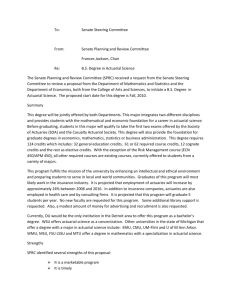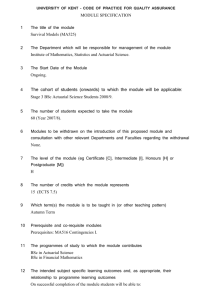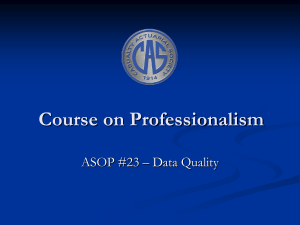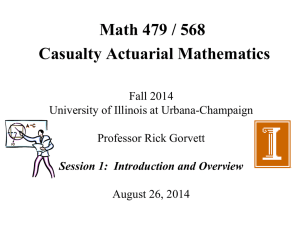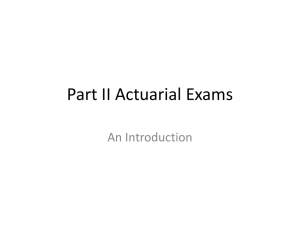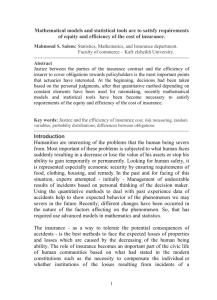Really good in Math? Try Actuarial Science (word
advertisement
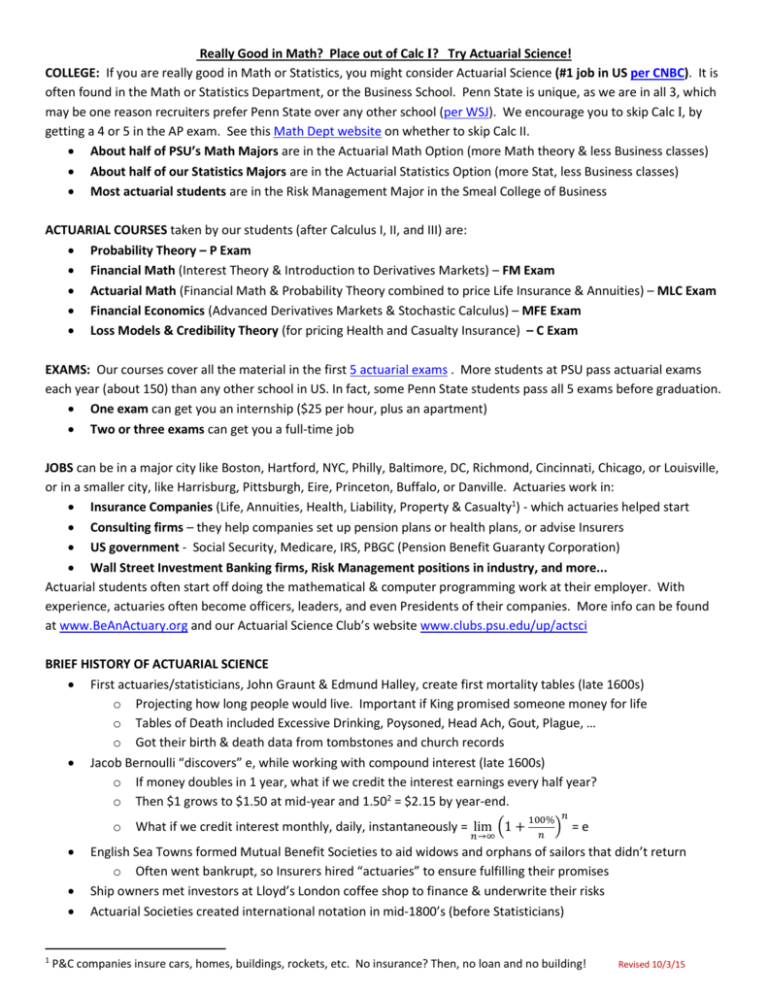
Really Good in Math? Place out of Calc I? Try Actuarial Science! COLLEGE: If you are really good in Math or Statistics, you might consider Actuarial Science (#1 job in US per CNBC). It is often found in the Math or Statistics Department, or the Business School. Penn State is unique, as we are in all 3, which may be one reason recruiters prefer Penn State over any other school (per WSJ). We encourage you to skip Calc I, by getting a 4 or 5 in the AP exam. See this Math Dept website on whether to skip Calc II. About half of PSU’s Math Majors are in the Actuarial Math Option (more Math theory & less Business classes) About half of our Statistics Majors are in the Actuarial Statistics Option (more Stat, less Business classes) Most actuarial students are in the Risk Management Major in the Smeal College of Business ACTUARIAL COURSES taken by our students (after Calculus I, II, and III) are: Probability Theory – P Exam Financial Math (Interest Theory & Introduction to Derivatives Markets) – FM Exam Actuarial Math (Financial Math & Probability Theory combined to price Life Insurance & Annuities) – MLC Exam Financial Economics (Advanced Derivatives Markets & Stochastic Calculus) – MFE Exam Loss Models & Credibility Theory (for pricing Health and Casualty Insurance) – C Exam EXAMS: Our courses cover all the material in the first 5 actuarial exams . More students at PSU pass actuarial exams each year (about 150) than any other school in US. In fact, some Penn State students pass all 5 exams before graduation. One exam can get you an internship ($25 per hour, plus an apartment) Two or three exams can get you a full-time job JOBS can be in a major city like Boston, Hartford, NYC, Philly, Baltimore, DC, Richmond, Cincinnati, Chicago, or Louisville, or in a smaller city, like Harrisburg, Pittsburgh, Eire, Princeton, Buffalo, or Danville. Actuaries work in: Insurance Companies (Life, Annuities, Health, Liability, Property & Casualty1) - which actuaries helped start Consulting firms – they help companies set up pension plans or health plans, or advise Insurers US government - Social Security, Medicare, IRS, PBGC (Pension Benefit Guaranty Corporation) Wall Street Investment Banking firms, Risk Management positions in industry, and more... Actuarial students often start off doing the mathematical & computer programming work at their employer. With experience, actuaries often become officers, leaders, and even Presidents of their companies. More info can be found at www.BeAnActuary.org and our Actuarial Science Club’s website www.clubs.psu.edu/up/actsci BRIEF HISTORY OF ACTUARIAL SCIENCE First actuaries/statisticians, John Graunt & Edmund Halley, create first mortality tables (late 1600s) o Projecting how long people would live. Important if King promised someone money for life o Tables of Death included Excessive Drinking, Poysoned, Head Ach, Gout, Plague, … o Got their birth & death data from tombstones and church records Jacob Bernoulli “discovers” e, while working with compound interest (late 1600s) o If money doubles in 1 year, what if we credit the interest earnings every half year? o Then $1 grows to $1.50 at mid-year and 1.502 = $2.15 by year-end. o 1 What if we credit interest monthly, daily, instantaneously = lim (1 + 𝑛→∞ 100% 𝑛 ) 𝑛 =e English Sea Towns formed Mutual Benefit Societies to aid widows and orphans of sailors that didn’t return o Often went bankrupt, so Insurers hired “actuaries” to ensure fulfilling their promises Ship owners met investors at Lloyd’s London coffee shop to finance & underwrite their risks Actuarial Societies created international notation in mid-1800’s (before Statisticians) P&C companies insure cars, homes, buildings, rockets, etc. No insurance? Then, no loan and no building! Revised 10/3/15 Actuaries were some of the first major users of computers, and helped design them Actuaries started sports statistics companies and have written books on gambling, chess, and bridge Shows with actuaries o Double Indemnity (1944) – Edward G Robinson, actuary, is suspicious about someone’s death o Are You With It: (1948) – Donald O’Connor, actuary, joins carnival after misplacing decimal in table o Sweet Charity (1969) – romantic life of an actuary who loves Shirley MacLaine o Tron (1982) – huge actuarial program, named RAM, inside the Master Computer o Along Came Polly (2004) – Ben Stiller, actuary, manages risk at work and in his own life o Kim Possible (2002-2007) – Ron Stoppable’s dad is named Actuary of the Year ACTUARIAL WORK: Here’s a snippet of what actuaries study and do in their jobs: Financial Mathematics: If you invest $100 at say 6%, you will have $100 · 1.06 = $106 in 1 year and $100 · (1.06)12 = $201.22 in 12 years.2 Thus, Future Value = FV = Starting Value · (1 + i)n where i = interest rate (6% in the above example) Conversely, if you want to have $100 in n years, you would need to invest Present Value = PV = FV/(1 + i)n now Annuity: if you invest $1 at the end of every year from now until you retire at age 65 (say 40 years), you will have: 𝑛 ∑39 𝑛=0 $1 ∙ (1 + 𝑖) = 1−(1+𝑖)40 1−(1+𝑖) = (1+𝑖)40 −1 𝑖 = $155 (if i = 6%) How much should you contribute annually if you want to be a millionaire at age 65? $1,000,000/155 = $6,4613 Actuarial Mathematics: Now you are age 65 and have $1 million dollars. How will you spread it over your remaining lifetime, so that you don’t run out of money (even if you live a long time or the stock market crashes)? By law, a bank can’t sell this.4 They can’t work with probabilities - only an insurance company can, because the law allows them to use actuarial mathematics, which reflects the possibility that you won’t need a payment at age 100, if you are not alive. The cost of $1 every year for the rest of your life is: 50 ∑ $1 ∙ 𝑡=0 Pr[𝐿𝑖𝑣𝑖𝑛𝑔 𝑡𝑜 𝑎𝑔𝑒 65 + 𝑡] (1 + 𝑖)𝑡 Actuaries have a symbol for that (ä65) and it’s around $12 (if the current interest rate is around 6%). It depends on interest rates, age, gender, and calendar year (future generations will probably live longer). And, it has a Variance since some people live less than the average life expectancy, and some live much longer. Thus, it costs $12 to pay out $1 every year for the rest of someone’s life. With a $1 million dollars, you can pay $83,333 annually for life. Financial Economics: Look up the Black-Scholes formula. It helps price Stock Options, using Stochastic Calculus and Brownian Motion (which Einstein used in one of his 1905 papers that won the Nobel Prize, but was “discovered” earlier by financial analysts). It’s pretty tough. The price of a Call Option = S0 · e–δ ∙ t · N(d1) – K · e–r ∙ t · N(d2), where N(d) is the Cumulative Distribution Fcn for the Standard Normal Distribution (bell curve), S0 is today’s stock price, r = rate of return, 𝑆 𝑒 −𝛿𝑡 1 0 2 σ2 is the variance in the stock’s return, δ is its dividend rate, d1 = [ln ( 𝐾𝑒 −𝑟𝑡 ) + 2 𝜎 𝑡]/𝜎 √𝑡 , d2 = d1 - 𝜎 √𝑡 , and t = time. Ron Gebhardtsbauer, FSA Faculty-in-Charge, Actuarial Science program Penn State University rug16@psu.edu 2 Rule of 72: your money doubles when i ∙ n = 72%, where “i” is the interest rate. How would you derive the 72? Solve for n in (1+i)n = 2, multiply n by i, do a Taylor Series Expansion of ln(1+i) to the i 2 term, & plug in a typical rate of i = 8%. 3 What if your contribution grows by g% every year? Or payments = n2 ? That was a Math Olympiad question in the past. 4 Well, actually, a bank can do this by just promising you a benefit for say 50 years. That should last your lifespan. But why waste all that money (by paying a larger price for it) when you may not live that long?

